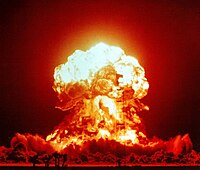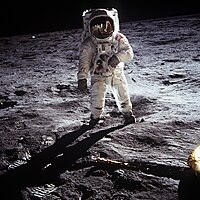Military-industrial-academic complex
(The Hoover Dam on the Arizona-California border was one of many large-scale water-power projects)
In the 20th century, the pace of technological developments increasingly became tied into a complex set of interactions betweenCongress, the industrial manufacturers, university research, and themilitary establishment. This set of relations, known more popularly as the "military-industrial complex," emerged because the military's unique technological demands, concentration of funding, large-scale application, and highly centralized control played a dominant role in driving technological innovation. Fundamental advances in medicine,physics, chemistry, computing, aviation, material science, naval architecture, and meteorology, among other fields, can be traced back to basic and applied research for military applications. Smokestack America became a nickname applied to traditional manufacturing core of U.S. industry, used to represent particular industries,[62] regions, or towns.
Cold War and Space Race
Manhattan project, procurement, government R&D, technology gap
American Robert Goddardwas one of the first scientists to experiment with rocketpropulsion systems. In his small laboratory inWorcester, Massachusetts, Goddard worked with liquid oxygen and gasoline to propel rockets into theatmosphere, and in 1926 successfully fired the world's first liquid-fuel rocket which reached a height of 12.5 meters. Over the next 10 years, Goddard's rockets achieved modest altitudes of nearly two kilometers, and interest in rocketry increased in the United States, Britain, Germany, and the Soviet Union.
At the close of World War II, both the American and Russian forces recruited or smuggled top German scientistslike Wernher von Braun back to their respective countries to continue defense-related work. Expendable rockets provided the means for launching artificial satellites, as well as manned spacecraft. In 1957 the Soviet Unionlaunched the first satellite, Sputnik I, and the United States followed with Explorer I in 1958. The first manned space flights were made in early 1961, first by Soviet cosmonaut Yuri Gagarin and then by American astronautAlan Shepard.
From those first tentative steps, to the 1969 Apollo program landing on the Moon, to today's reusable Space Shuttle, the American space program has brought forth a breathtaking display of applied science.Communications satellites transmit computer data, telephone calls, and radio and television broadcasts.Weather satellites furnish the data necessary to provide early warnings of severe storms.


